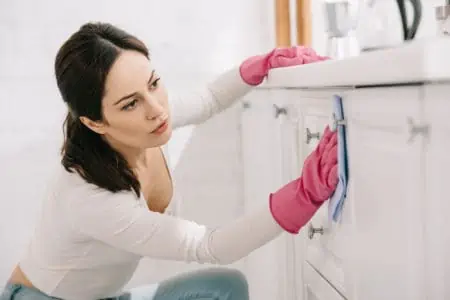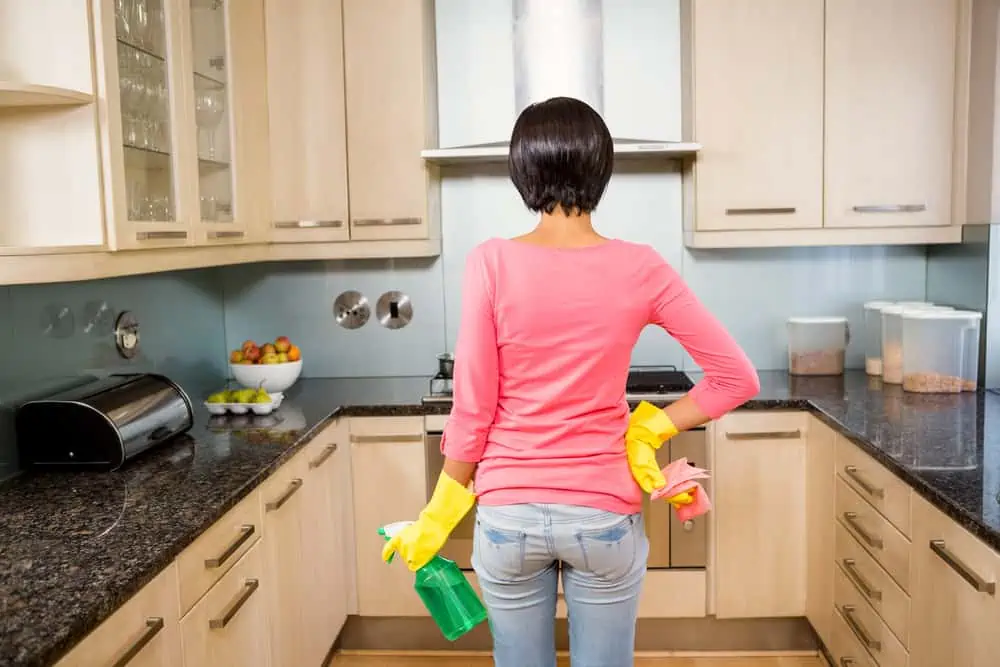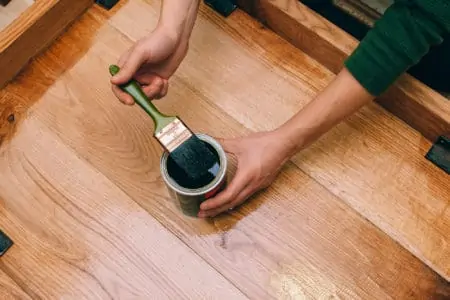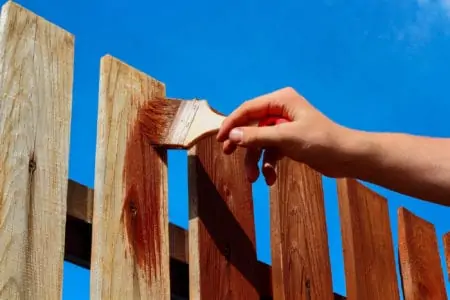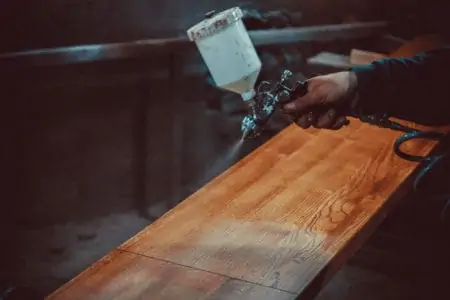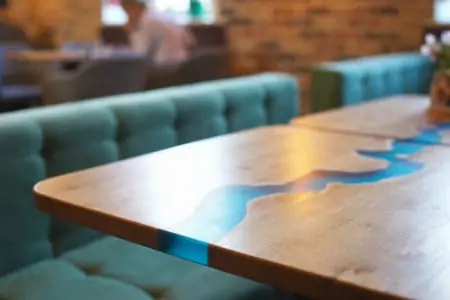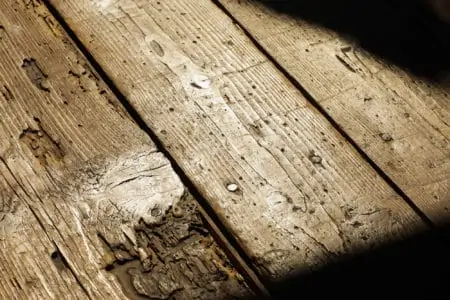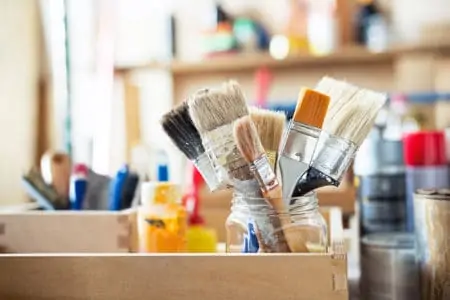A remodel transforms tired kitchens, making them feel fresh and new. However, because of the demands placed on your kitchen, it can get dirty very quickly. So, what is the best way to clean painted cabinets?
We explain how to clean painted cabinets and offer hints and tips for the best outcome. Plus, we reveal which is the best cleaner for painted cabinets.
Key Takeaways
- Use dish soap, warm water, and a microfiber cloth for general cleaning and lighter stains.
- For tougher stains, create a paste using vinegar and baking soda, and work in circular motions.
- Be cautious with cleaning products, as harsh chemicals can strip lacquer from cabinets.
- Regularly clean painted cabinets to maintain their appearance and prevent damage.
How Often to Clean Painted Cabinets?
The best way to clean painted cabinets is to do it regularly. If you want your shiny white cabinets to stay looking good, you should set aside time to clean. Cooking creates greasy spots, oil will stain your wooden work surface, and coffee leaves dirty ring marks.
You should set aside an hour or two twice a month to wipe down your kitchen cabinets. That should keep the gloss surfaces looking like they have just been painted. Try performing a deep clean every three to six months.
Best Commercial Cleaner for Painted Cabinets
There are two ways to clean your painted cabinets: using commercial cleaning products and homemade cleaners. Both have their merits, but first, let’s take a tour of some branded products.
Take Note
It is crucial that you use gentle detergents because harsh chemicals can strip lacquer from your kitchen cabinets.
Murphy Oil Soap
Murphy Oil Soap cleans hardwood floors, natural wood cabinets, painted surfaces, and just about anything else. It contains 99 percent naturally derived ingredients and is 100 percent biodegradable.
It’s a win, win: clean painted cabinets and a healthy environment!
Weiman Wood Spray Polish and Cleaner
Weiman is another well-known brand of wooden and painted cabinet cleaner. It rejuvenates painted surfaces and prevents drying and cracking without removing the finish. The formula is silicone-free, wax-free, and is guaranteed long-lasting.
Rejuvenate Cabinet and Furniture Restorer
This Rejuvenate Cabinet Restorer has a polymer-based formula. It restores shine, fills cracks, and stops fading. You can use this product on laminate, vinyl, wood, and painted surfaces.
Parker and Bailey Kitchen Cabinet Cream
Parker and Bailey products have been cleaning painted cabinets since 1879. The formula is free from petrochemicals, wax, silicone, or other harmful ingredients.
So, it stands to reason their Kitchen Cabinet Cream is an effective degreaser to use on your painted surfaces. It cleans, restores, and removes food stains and grease from your painted cabinets.
Howard Products Wood Polish and Cleaner
This product is one of the best cleaners for painted cabinets. If you want a cleaner to trust, put your faith in over 30,000 reviews on Amazon because they can’t all be wrong.
Howard Products Wood Polish uses carnauba and beeswax to leave a soft luster, restoring old cabinets that have yellowed.
Best Homemade Cleaning Products
With so many commercial cleaners to choose from, what about using a DIY approach and natural products? It could save you money and time, as well as help to save the planet.
White Vinegar
Vinegar is experiencing a resurgence as a cleaning product. Not only does it make your fish and chips taste good, but it also cleans painted kitchen cabinets. You would only want a weak solution because vinegar is an acid.
Mix three cups of warm water into a spray bottle and add half a cup of vinegar. Vinegar removes grease, mold, oil, and any other food stains. It is also excellent for cleaning stovetops and other appliances.
Top Tip
With vinegar, you can up the content if your stain is particularly stubborn; mix two parts of water to one part of vinegar.
Baking Soda
Baking soda is one of those cure-all ingredients. It unblocks drains and toilets, cleans shower screens, and removes mold. Baking soda also cleans painted kitchen cabinets.
Mix three tablespoons of soda into three cups of water and coat the stained surface. Wipe it clean using a soft cloth to avoid scratching the painted surfaces.
Dish Soap
Simple dish soap is an excellent way of removing grease, stains, and food splatters from painted kitchen cabinets. And the good news is that everyone has dish soap to hand. Just squirt some into a bucket and add warm water.
Wipe the cabinets with soft sponges to avoid scratching.
How to Clean Greasy Painted Cabinets
Grease is ever-present in kitchens. Frying, roasting, and grilling produce plenty of splatters that stain cabinets and countertops. Using natural ingredients can sometimes be the best solution.
What You’ll Need
- Microfiber cloth.
- Two teaspoons of dish soap.
- Three cups of warm water.
- Bucket.
- Three tablespoons of baking soda.
- One cup of white vinegar.
- Rubber gloves.
- Spray bottle.
- Mix the ingredients into a bucket, adding warm water.
- Test a small inconspicuous area of your cabinet to check that the solution is gentle enough. It should be, but it is always better to check it won’t fade your matte surfaces.
- Pour some of the solution into a spray bottle and apply it to the greasy spots.
- Wait while the solution gets to work.
- Soak the microfiber cloth and squeeze it out. Wipe it over the cabinet using circular motions.
- Wet a second cloth with warm water and wipe away the residue of the solution and grease.
- Now grab a dry cloth and remove the excess moisture. If you leave it to sit, it will discolor the cabinets.
- Because you have only used natural ingredients, you can pour the excess formula down the kitchen sink.
How to Clean Stains On Painted Cabinets
Cleaning grease is one thing, but stains are dried on, so they are harder to remove. You will need to step up the ratios of baking soda to make an impact.
What You’ll Need
- Bucket.
- One part of warm water.
- Two parts of baking soda.
- Three drops of dish soap.
- Microfiber cloth.
- Mix the ingredients into a bucket.
- Wet the microfiber cloth and wring it out.
- Using a gentle circular motion, rub with enough force to remove the stain and not the paint.
- Wipe the cabinet clean with a dry microfiber cloth.
Top Tip
Wet a cloth and scoop up the baking soda and dish soap and rub it onto the stain as a paste. Then wash it clean with warm water.
How to Polish Painted Cabinets
Once the cabinets are clean, you will need to polish them. But how do you do that without discoloring the surfaces or damaging the paintwork?
What You’ll Need
- Microfiber cloth.
- Furniture wax.
- Make sure the cabinets have been thoroughly cleaned.
- Soak the microfiber cloth with the furniture wax. This Mr. Siga pack of 12 cloths should do the trick.
- Rub the wax onto the painted surfaces in circular motions.
- Cover the entire surface, working one cabinet at a time.
- Use a clean microfiber cloth to buff the cabinet surface until you get a high sheen.
- If necessary, repeat the process to get a more durable coating with a better sheen.
How Do You Clean Painted Cabinets Without Removing Paint?
The danger of cleaning dark or stubborn stains from painted cabinets is you risk rubbing away the paintwork. Some blemishes are so ingrained that it can be challenging to remove them without causing some damage.
Wipe Them Down Regularly
One of the best ways of removing stains without fading the paint is to do it regularly. Not only does it keep your kitchen clean, but it also preserves the paintwork. You should do this as part of your regular cleaning regime.
Wipe Up Spills
Don’t leave spills to sit and dry. The longer you leave the blemish, the harder it will be to remove. And that means more vigorous rubbing, putting your painted surfaces at risk.
Use Soft Cloths
Soft microfiber cloths are the best products to use because they are gentle to the painted surfaces. They are 100 percent non-abrasive, so while they may take longer to remove stubborn marks, they also preserve the paint.
Use Grease-Cutting Detergents
Grease is hard to remove, so a degreasing agent cuts through the stain, meaning it is less of an effort to remove. If you reduce the amount of rubbing needed, you keep the paintwork below in pristine condition.
Take Note
Never use abrasive detergents like bleach or ammonia on your painted surfaces. They remove the stain and the paint too.
Use Natural Ingredients
Baking soda, white vinegar, lemon juice, and other citrus-based solutions are excellent for cutting through grease and stains. You can use baking soda as a paste for stubborn marks or mix it into a water-based solution for general application.
FAQs
The Last Word
Preventing your painted cabinets from fading or getting stained is the ideal scenario. It saves significant deep cleaning and stops splatters and stains from drying hard. Cleaning little and often is better because you can do it with a soapy cloth in less than an hour.
That’s got to beat rolling up your sleeves and working up a sweat.
